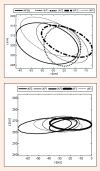The variability of the serve toss in tennis under the influence of artificial crosswind
- PMID: 24149810
- PMCID: PMC3761841
The variability of the serve toss in tennis under the influence of artificial crosswind
Abstract
This study was made to analyze the variability and stability of the serve toss in tennis, on the x (side-to-side), y (back-to-front) and z (vertical) axes, with 12 experienced players under the influence of crosswind (induced aerodynamic flow) produced by an industrial ventilator. The players were analyzed individually after serving at maximum speed and accuracy to the intersection point of the centre line and service line ("T "point). The results allow us to conclude that the experienced players tend to stabilize the vertical dimension of the service (z axis). Additionally, this study confirms the invariability of the player height ratio: height of impact (1:1.5) in experienced players even when constrained by the "artificial crosswind. "Given the above, the vertical dimension of the tennis serve is assumed as a constant feature, which is guaranteed in the remaining varying dimensions (y and x axes) of the ball toss. Thus, the variability should be seen as part of the solution and not as something to be avoided by players and coaches. Key PointsAnalysis of the tennis serve variability under the effect of artificial crosswindTwelve experienced tennis players performed a set of 20 free serves (without wind constraints), and four other sets of 20 serves under different practice conditions (with different crosswind intensities)The players tend to stabilize in the z axis and vary in the y- (back-to-front) and x-axes (side-to-side) during the ball toss tennis serve in all the practice conditions (with and without crosswind)THE MAINTENANCE OF A PLAYER HEIGHT RATIO: impact height of approximately 1:1.5 in experienced players, even when constrained by "artificial crosswind".
Keywords: Variability; crosswind; motor control; performance; tennis serve.
Figures



References
-
- American Sport Education Program (2009) Coaching tennis technical and tactical skills. Champaign: Human Kinetics
-
- Bahamonde R.E. (2000). Changes in angular momentum during the tennis serve. Journal of Sports Sciences 18(8), 579-592 - PubMed
-
- Bennett S.J., Davids K., Handford C., Kingsbury D. (2001) Information--movement coupling: Implications for the organization of research and practice during acquisition of self-paced extrinsic timing skills. Journal of Sports Sciences 19(2), 117-127 - PubMed
-
- Bollettieri N. (2001) Bollettieri’s Tennis Handbook. Champaign: Human Kinetics
-
- Brody H. (1987) Tennis science for tennis players. Philadelphia: University of Pennsylvania Press
LinkOut - more resources
Full Text Sources
Research Materials
